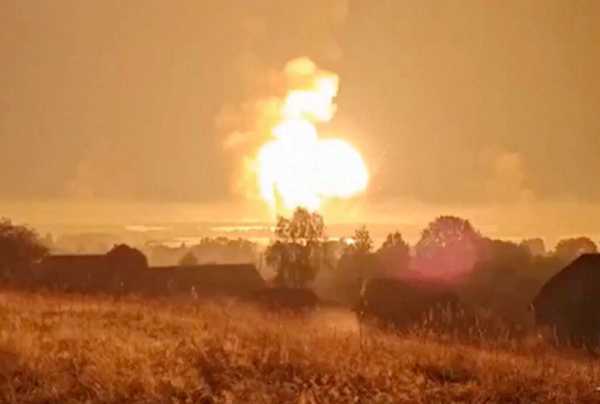
As the full-scale Russian invasion of Ukraine approaches its third winter, the biggest topic of debate is the reluctance among Kyiv’s key partners to sanction long-range attacks inside Russia using Western weapons. According to skeptics in Washington DC and elsewhere, deep strikes would pose an unacceptable risk and could spark a far wider war.
In typical fashion, Russian President Vladimir Putin has exploited this Western fear of escalation. The Kremlin dictator has recently vowed to lower the threshold for Russian nuclear strikes, and has warned that any long-range attacks on Russian territory would mean that NATO is “at war” with Russia.
So far, Putin’s nuclear saber-rattling appears to be working. Despite extensive public and private lobbying, Ukrainian President Volodymyr Zelenskyy came away from his widely anticipated late September visit to the United States without having achieved a breakthrough.
Officials in Kyiv regard the current restrictions on attacks inside Russia as politically unjustified and militarily absurd. They argue that by preventing Ukraine from striking back, Western leaders are effectively protecting Putin’s war machine while forcing the Ukrainian military to fight with one hand tied behind its back.
With little indication that Ukraine’s major allies are ready to change tack and allow the use of Western-supplied missiles inside Russia, it may be time to explore other options. The most obvious solution would be to enhance Ukraine’s ability to launch attacks inside Russia using its own domestically-produced long-range weapons.
Ukraine’s rapidly advancing domestic drone program already has considerable long-range capabilities, but requires extensive investment and technological cooperation in order to reach its full potential. Ukraine has also recently confirmed the successful testing of its first domestically-produced ballistic missile. With sufficient Western support, this expanding Ukrainian arsenal of long-range weapons could have a major impact on the future course of the war.
Since the beginning of 2024, Ukraine has been conducting an increasingly ambitious campaign of drone strikes against military targets and energy industry infrastructure deep inside Russia. Many of these attacks have taken place at distances more than one thousand kilometers from the Ukrainian border and have involved large numbers of drones that have succeeded in overwhelming Russia’s air defenses.
The potential of Ukraine’s long-range drones was underlined in September when a large-scale attack on a military storage facility in Russia’s Tver region produced an explosion that was large enough to be picked up by earthquake monitoring stations. According to Ukrainian sources, the blast destroyed vast quantities of Russian missiles, glide bombs, and artillery ammunition. Satellite imagery appeared to confirm that the targeted facility had been partially destroyed.
Some of Ukraine’s partners were initially reluctant to back this air offensive, with multiple US officials publicly questioning the wisdom of Kyiv’s strategy. However, these concerns appear to have eased in recent months. Western officials are now more publicly supportive of Ukraine’s right to strike back inside Russia, provided this is done using Ukrainian weapons.
Over the past two and a half years, drones have emerged as a vital asset in Ukraine’s asymmetric warfare strategy as it fights to defend itself against a far larger and more powerful adversary. Outgunned and outnumbered by Russia, Ukraine has focused its resources on building up the country’s domestic drone industry. In the air, on land, and at sea, domestically-made drones have been instrumental in many of Ukraine’s most important military successes.
Ukrainian drone output has dramatically increased since the onset of Russia’s full-scale invasion, with more than two hundred companies now producing millions of drones annually. The expansion of the sector has been so rapid that Ukraine is currently making more drones than the Ukrainian authorities can afford to purchase, leading to excess capacity. Unless this can be addressed, there is a danger that many Ukrainian drone companies could be forced out of business or obliged to move abroad.
Ukraine’s partners can bridge the gap between rising drone manufacturing capacity and the country’s limited state procurement budgets by placing orders directly with Ukrainian drone manufacturers themselves. Some countries including Denmark have already committed to do so. More comprehensive efforts in this direction could place Ukraine’s dynamically developing drone industry on a firmer footing and bolster the country’s ability to hit targets deep inside Russia.
In early October, Ukrainian Defense Minister Rustem Umerov confirmed that increased production of long-range drones and missiles will be a key goal in 2025. Ukraine’s partners should follow suit and prioritize their support for the country’s long-range air strike capabilities. By expanding investment and technical cooperation in this area, they can help Ukraine regain the initiative and force Putin to rethink his invasion, while at the same time adhering to their own cautious doctrine of escalation management. Western policymakers may still believe in Putin’s red lines, but Ukrainians do not.
David Kirichenko is an Associate Research Fellow at the Henry Jackson Society.
Source: euractiv.com



